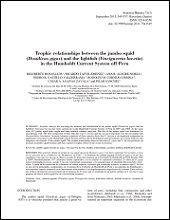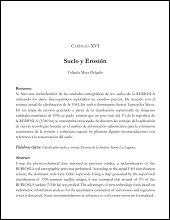Trophic relationships between the jumbo squid (Dosidicus gigas) and the lightfish (Vinciguerria lucetia) in the Humboldt Current System off Peru
Relaciones tróficas entre el calamar gigante Dosidicus gigas y el pez luminoso Vinciguerria lucetia en el sistema de la corriente de Humboldt de Perú
Autor
RIGOBERTO ROSAS LUIS
RICARDO TAFUR - JIMÉNEZ
Ana Renza Paola Alegre Norza Sior
Pedro Ramiro Castillo Valderrama
Rodolfo Cornejo
CESAR AUGUSTO SALINAS ZAVALA
Pilar Sanchez
Metadatos
Mostrar el registro completo del ítemResumen
"Acoustic surveys for assessing the biomass and distribution of the jumbo squid (Dosidicus gigas) and the lightfish (Vinciguerria lucetia) were carried out in the Humboldt Current System of Peru in 2007 and 2008. At the same time, 937 jumbo squid were caught and their stomach contents analyzed. The diet of the jumbo squid was dominated by mesopelagic fish. The first component of their fish diet was V. lucetia and the second component was the myctophid fish Diogenichthys laternatus. Acoustic biomass estimates of these species show that V. lucetia is an important component in aggregative structures in the Humboldt Current System of Peru and its distribution and movements are closely related to the migratory movements of the jumbo squid. The trophic relationship observed between D. gigas and V. lucetia promotes an increase in jumbo squid biomass and, has a positive trophic effect on the ocean ecosystem." "La biomasa de calamar gigante Dosidicus gigas y el pez mesopelágico Vinciguerria lucetia se obtuvo a partir de detección acústica en la Corriente de Humboldt de Perú durante 2007 y 2008. Simultáneamente, 937 calamares fueron capturados y se les analizó el contenido estomacal. La dieta de D. gigas estuvo dominada por peces, siendo V. lucetia el principal componente y en segundo lugar el mictófido Diogenichthys laturnatus. A partir de la evaluación de la biomasa de ambas especies, estimada por el método acústico, se observó que V. lucetia es uno de los principales componentes en el sistema de la Corriente de Humboldt de Perú y sus patrones de distribución y movimientos espacio-temporal están fuertemente relacionados a los desplazamientos migratorios del calamar. Estas relaciones tróficas promueven un incremento de la biomasa de D. gigas que es resultado de un patrón similar en V. lucetia, lo que propicia un efecto trófico positivo en el ecosistema oceánico."
Colecciones
Ítems relacionados
Mostrando ítems relacionados por Título, autor o materia.
-
PROMOCIÓN DEL PERIFITON PARA EL CULTIVO DE CAMARÓN BLANCO: HACIA UNA ACUICULTURA ECOLÓGICA
DOMENICO VOLTOLINA LOBINA; JUAN MANUEL AUDELO NARANJO; MARIA DEL ROSARIO PACHECO MARGES -
Suelo y Erosión
YOLANDA LOURDES MAYA DELGADO


